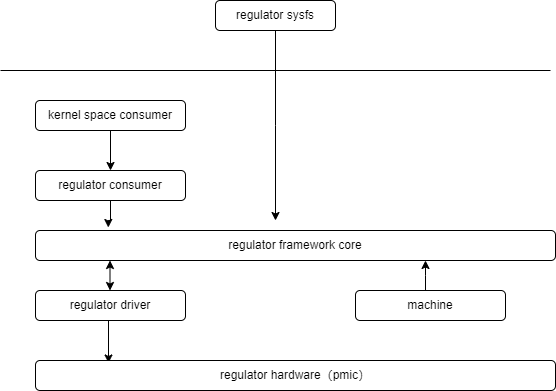PMIC
本文介绍 Linux 中 Regulator 子系统的功能及使用方法。
模块介绍
Regulator(电源调节器)子系统主要用于控制能够输出电压和电流的硬件模块,我司P1芯片就是一款包含该功能的PMIC。对于 Linux 内核来说,regulator 是一套标准的软件框架,提供统一的接口用于控制各类电压/电流输出设备。
功能介绍

- regulator consumer: 有调节器供电的设备,他们消耗调节器提供的电力
- regulator framework: 提供标准的内核接口,控制系统的voltage/current regulators,并提供相应的开关、电压/电流设置的机制
- regulator diver: regulator 的驱动代码,负责向 framework 注册设备,并且与底层硬件通讯
- machine: 主要是配置各个regulator的属性,如电压范围、初始状态等。
源码结构介绍
Regulator 模块在内核源码中的路径为 drivers/regulator/,目录结构如下:
drivers/regulator/
├── core.c
├── devres.c
├── dummy.c
├── dummy.h
├── fixed.c
├── fixed-helper.c
├── gpio-regulator.c
├── helpers.c
├── internal.h
├── irq_helpers.c
├── Kconfig
├── Makefile
├── of_regulator.c
├── spacemit-regulator.c
关键特性
特性
| 特性 | 特性说明 |
|---|---|
| 支持 6路 DCDC | 支持动态调压:enable/disable |
| 支持 5路 ALDO | 支持调压:enable/disable |
| 支持 7路 DLDO | 支持调压:enable/disable |
配置介绍
主要包括 驱动使能配置 和 DTS 配置
CONFIG 配置
CONFIG_REGULATOR_SPACEMIT:
This driver provides support for the voltage regulators on the
spacemit pmic.
Symbol: REGULATOR_SPACEMIT [=y]
Type : tristate
Defined at drivers/regulator/Kconfig:1666
Prompt: Spacemit regulator support
Depends on: REGULATOR [=y] && MFD_SPACEMIT_PMIC [=y]
Location:
-> Device Drivers
-> Voltage and Current Regulator Support (REGULATOR [=y])
-> Spacemit regulator support (REGULATOR_SPACEMIT [=y])
Selects: REGULATOR_FIXED_VOLTAGE [=y]
DTS 配置
&i2c8 {
pinctrl-names = "default";
pinctrl-0 = <&pinctrl_i2c8>;
status = "okay";
spm8821@41 {
compatible = "spacemit,spm8821";
reg = <0x41>;
interrupt-parent = <&intc>;
interrupts = <64>;
status = "okay";
vcc_sys-supply = <&vcc4v0_baseboard>;
dcdc5-supply = <&dcdc_5>;
regulators {
compatible = "pmic,regulator,spm8821";
/* buck */
dcdc_1: DCDC_REG1 {
regulator-name = "dcdc1";
regulator-min-microvolt = <500000>;
regulator-max-microvolt = <3450000>;
regulator-always-on;
};
dcdc_2: DCDC_REG2 {
regulator-name = "dcdc2";
regulator-min-microvolt = <500000>;
regulator-max-microvolt = <3450000>;
regulator-always-on;
};
dcdc_3: DCDC_REG3 {
regulator-name = "dcdc3";
regulator-min-microvolt = <500000>;
regulator-max-microvolt = <1800000>;
regulator-always-on;
};
dcdc_4: DCDC_REG4 {
regulator-name = "dcdc4";
regulator-min-microvolt = <500000>;
regulator-max-microvolt = <3300000>;
regulator-always-on;
};
dcdc_5: DCDC_REG5 {
regulator-name = "dcdc5";
regulator-min-microvolt = <500000>;
regulator-max-microvolt = <3450000>;
regulator-always-on;
};
dcdc_6: DCDC_REG6 {
regulator-name = "dcdc6";
regulator-min-microvolt = <500000>;
regulator-max-microvolt = <3450000>;
regulator-always-on;
};
/* aldo */
ldo_1: LDO_REG1 {
regulator-name = "ldo1";
regulator-min-microvolt = <500000>;
regulator-max-microvolt = <3400000>;
regulator-boot-on;
};
ldo_2: LDO_REG2 {
regulator-name = "ldo2";
regulator-min-microvolt = <500000>;
regulator-max-microvolt = <3400000>;
};
ldo_3: LDO_REG3 {
regulator-name = "ldo3";
regulator-min-microvolt = <500000>;
regulator-max-microvolt = <3400000>;
};
ldo_4: LDO_REG4 {
regulator-name = "ldo4";
regulator-min-microvolt = <500000>;
regulator-max-microvolt = <3400000>;
};
/* dldo */
ldo_5: LDO_REG5 {
regulator-name = "ldo5";
regulator-min-microvolt = <500000>;
regulator-max-microvolt = <3400000>;
regulator-boot-on;
};
ldo_6: LDO_REG6 {
regulator-name = "ldo6";
regulator-min-microvolt = <500000>;
regulator-max-microvolt = <3400000>;
};
ldo_7: LDO_REG7 {
regulator-name = "ldo7";
regulator-min-microvolt = <500000>;
regulator-max-microvolt = <3400000>;
};
ldo_8: LDO_REG8 {
regulator-name = "ldo8";
regulator-min-microvolt = <500000>;
regulator-max-microvolt = <3400000>;
regulator-always-on;
};
ldo_9: LDO_REG9 {
regulator-name = "ldo9";
regulator-min-microvolt = <500000>;
regulator-max-microvolt = <3400000>;
};
ldo_10: LDO_REG10 {
regulator-name = "ldo10";
regulator-min-microvolt = <500000>;
regulator-max-microvolt = <3400000>;
regulator-always-on;
};
ldo_11: LDO_REG11 {
regulator-name = "ldo11";
regulator-min-microvolt = <500000>;
regulator-max-microvolt = <3400000>;
};
sw_1: SWITCH_REG1 {
regulator-name = "switch1";
};
};
};
};
接口描述
API 介绍
请参考内核文档:
Documentation/power/regulator/consumer.rst
Documentation/power/regulator/machine.rst
Documentation/power/regulator/regulator.rst
Demo 示例
- 配置dts,引用想要使用的regulator
&cpu_0 {
clst0-supply = <&dcdc_1>;
vin-supply-names = "clst0";
};
- 代码中获得相应的句柄:
const char *strings;
struct regulator *regulator;
err = of_property_read_string_array(cpu_dev->of_node, "vin-supply-names",
&strings, 1);
regulator = devm_regulator_get(cpu_dev, strings); --> 传入的struct device *必须有实体对应
- 代码中使能相应的regulator:
regulator_enable(regulator);
- 代码中设置相应的regulator的电压:
regulator_set_voltage(regulator, 95000000, 95000000);
Debug介绍
待补充
FAQ
待补充
附录
SPL/U-Boot 配置说明
uboot-2022.10$ vi arch/riscv/dts/k1-x_spm8821.dtsi
&i2c8 {
clock-frequency = <100000>;
u-boot,dm-spl;
status = "okay";
spm8821: pmic@41 {
compatible = "spacemit,spm8821";
reg = <0x41>;
bus = <8>;
u-boot,dm-spl;
regulators {
/* buck */
dcdc_6: DCDC_REG1 {
regulator-name = "dcdc1";
regulator-min-microvolt = <500000>;
regulator-max-microvolt = <3450000>;
regulator-init-microvolt = <950000>;
regulator-boot-on;
u-boot,dm-spl;
regulator-state-mem {
regulator-off-in-suspend;
};
};
dcdc_7: DCDC_REG2 {
regulator-name = "dcdc2";
regulator-min-microvolt = <500000>;
regulator-max-microvolt = <3450000>;
};
dcdc_8: DCDC_REG3 {
regulator-name = "dcdc3";
regulator-min-microvolt = <500000>;
regulator-max-microvolt = <3450000>;
regulator-boot-on;
u-boot,dm-spl;
};
dcdc_9: DCDC_REG4 {
regulator-name = "dcdc4";
regulator-min-microvolt = <500000>;
regulator-max-microvolt = <3450000>;
};
dcdc_10: DCDC_REG5 {
regulator-name = "dcdc5";
regulator-min-microvolt = <500000>;
regulator-max-microvolt = <3450000>;
};
dcdc_11: DCDC_REG6 {
regulator-name = "dcdc6";
regulator-min-microvolt = <500000>;
regulator-max-microvolt = <3450000>;
};
/* aldo */
ldo_23: LDO_REG1 {
regulator-name = "ldo1";
regulator-min-microvolt = <500000>;
regulator-max-microvolt = <3400000>;
regulator-init-microvolt = <3300000>;
regulator-boot-on;
u-boot,dm-spl;
};
ldo_24: LDO_REG2 {
regulator-name = "ldo2";
regulator-min-microvolt = <500000>;
regulator-max-microvolt = <3400000>;
};
ldo_25: LDO_REG3 {
regulator-name = "ldo3";
regulator-min-microvolt = <500000>;
regulator-max-microvolt = <3400000>;
};
ldo_26: LDO_REG4 {
regulator-name = "ldo4";
regulator-min-microvolt = <500000>;
regulator-max-microvolt = <3400000>;
};
/* dldo */
ldo_27: LDO_REG5 {
regulator-name = "ldo5";
regulator-min-microvolt = <500000>;
regulator-max-microvolt = <3400000>;
};
ldo_28: LDO_REG6 {
regulator-name = "ldo6";
regulator-min-microvolt = <500000>;
regulator-max-microvolt = <3400000>;
};
ldo_29: LDO_REG7 {
regulator-name = "ldo7";
regulator-min-microvolt = <500000>;
regulator-max-microvolt = <3400000>;
};
ldo_30: LDO_REG8 {
regulator-name = "ldo8";
regulator-min-microvolt = <500000>;
regulator-max-microvolt = <3400000>;
};
ldo_31: LDO_REG9 {
regulator-name = "ldo9";
regulator-min-microvolt = <500000>;
regulator-max-microvolt = <3400000>;
};
ldo_32: LDO_REG10 {
regulator-name = "ldo10";
regulator-min-microvolt = <500000>;
regulator-max-microvolt = <3400000>;
};
ldo_33: LDO_REG11 {
regulator-name = "ldo11";
regulator-min-microvolt = <500000>;
regulator-max-microvolt = <3400000>;
};
sw_2: SWITCH_REG1 {
regulator-name = "switch1";
};
};
};
};
SPL 阶段电源开启及电压设置方法
dcdc_6: DCDC_REG1 {
regulator-name = "dcdc1";
regulator-min-microvolt = <500000>;
regulator-max-microvolt = <3450000>;
regulator-init-microvolt = <950000>; ---> 加上该字段,会自动设置该电源电压为0.95v
regulator-boot-on; ---> 加上该字段,在SPL阶段会自动打开该电源
u-boot,dm-spl; ---> 需要加该字段,SPL才可识别该dts node
regulator-state-mem {
regulator-off-in-suspend;
};
};
U-Boot 阶段电源开启及电压设置方法
U-Boot 阶段有两种方式设置或者开启电源
方式一:直接在 DTS 中配置
dcdc_6: DCDC_REG1 { --> regulator_get_by_devname传入的名字参数
regulator-name = "dcdc1";
regulator-min-microvolt = <500000>;
regulator-max-microvolt = <3450000>;
regulator-init-microvolt = <950000>; ---> 加上该字段,会自动设置该电源电压为0.95v
regulator-boot-on; ---> 加上该字段,在UBOOT阶段会自动打开该电源
regulator-state-mem {
regulator-off-in-suspend;
};
};
方式二:通过代码动态设置
1. 首先要获得想要设置或者开启电压的regulator句柄
struct udevice *rdev = NULL;
char *regulator_name = "DCDC_REG1" --> 该字段传入的是dts中标识的dts node的名字
ret = regulator_get_by_devname(regulator_name, &rdev);
2. 开启某一路电
regulator_set_enable(&rdev, true);
3. 设置某一路电的电压
regulator_set_value(&rdev, 1800000);